#concurrent migration
Explore tagged Tumblr posts
Text
#edbmails#Microsoft 365 tenant to tenant migration#office 365 migration software#concurrent migration
0 notes
Text
putting the sea peoples on a shelf until yall understand systems collapse theory and stop blaming an umbrella category of what were likely climate refugees and migrants for the collapse of every society in the late bronze age
#FREE THEM FROM THIS SCRUTINY THEY DID NOTHING WRONGGGGGGG#THERE WAS A DROUGHT + FAMINE + LIKE 50 OTHER CONCURRENT MIGRATIONS#(and probably a plague. on top of a collapsing economy)#its a funny haha but Man i’m startin to think its the only reason yall think the bronze age ended#and not all the Other Concurrent Shit that built up into One Pummel Session#and i dont see no one blamin the kaška people who were always clashing w the hittites… like its also inland migration guys…. guys….#then again the hittites were just constantly paranoid and on the verge of agricultural collapse so like. maybe that was a them problem anywa#<- not standing by this as an academic take but it is funny they made treaties w everyone and yall are like The Sea… It Must Be…#no theyre inland and paranoid as fuck they probably boarded up the windows and left before getting hit w famine#tagamemnon
13 notes
·
View notes
Text
[A]nti-homeless laws [...] rooted in European anti-vagrancy laws were adapted across parts of the Japanese empire [...] at the turn of the 20th century. [...] [C]riminalising ideas transferred from anti-vagrancy statutes into [contemporary] welfare systems. [...] [W]elfare and border control systems - substantively shaped by imperial aversions to racialised ideas of uncivilised vagrants - mutually served as a transnational legal architecture [...] [leading to] [t]oday's modern divides between homeless persons, migrants, and refugees [...].
---
By the Boer Wars (1880–1902), Euro-American powers and settler-colonial governments professed anxieties about White degeneration and the so-called “Yellow Peril” alongside other existential threats to White supremacy [...]. Japan [...] validated the creation of transnational racial hierarchies as it sought to elevate its own global standing [...]. [O]ne key legal instrument for achieving such racialised orders was the vagrancy concept, rooted in vagrancy laws that originated in Europe and proliferated globally through imperial-colonial conquest [...].
[A]nti-vagrancy regulation [...] shaped public thinking around homelessness [...]. Such laws were applied as a “criminal making device” (Kimber 2013:544) and "catch-all detention rationale" (Agee 2018:1659) targeting persons deemed threats for their supposedly transgressive or "wayward interiority" (Nicolazzo 2014:339) measured against raced, gendered, ableist, and classed norms [...]. Through the mid-20th century, vagrancy laws were aggressively used to control migration [and] encourage labour [...]. As vagrancy laws fell out of favour, [...] a "vagrancy concept" nonetheless thrived in welfare systems that similarly meted out punishment for ostensible vagrant-like qualities [...], [which] helps explain why particular discourses about the mobile poor have persisted to date [...].
---
During high imperialism (1870–1914), European, American, and Japanese empires expanded rapidly, aided by technologies like steam and electricity. The Boer Wars and Japan's ascent to Great Power status each profoundly influenced trans-imperial dynamics, hardening Euro-American concerns regarding a perceived deterioration of the White race. [...] Through the 1870s [...] the [Japanese] government introduced modern police forces and a centralised koseki register to monitor spatial movement. The koseki register, which recorded geographic origins, also served as a tool for marking racialised groups including Ainu, Burakumin, Chinese, [...] and Korean subjects across Japan's empire [...]. The 1880 Penal Code contained Japan's first anti-vagrancy statute, based on French models [...]. Tokyo's Governor Matsuda, known for introducing geographic segregation of the rich and poor, expressed concern around 1882 for kichinyado (daily lodgings), which he identified as “den[s] for people without fixed employment or [koseki] registration” [...].
Attention to “vagrant foreigners” (furō-gaikokujin) emerged in Japanese media and politics in the mid-1890s. It stemmed directly from contemporary British debates over immigration restrictions targeting predominantly Jewish “destitute aliens” [...].
The 1896 Landing Regulation for Qing Nationals barred entry of “people without fixed employment” and “Chinese labourers” [...], justified as essential "for maintaining public peace and morals" in legal documents [...]. Notably, prohibitions against Chinese labourers were repeatedly modified at the British consulate's behest through 1899 to ensure more workers for [the British-affiliated plantation] tea industry. [...]
---
Simultaneously, new welfaristic measures emerged alongside such punitive anti-vagrancy statutes. [...] Such border control regulations were eventually standardised in Japan's first immigration law, the 1918 Foreigners’ Entry Order. [...] This turn towards instituting racialised territorial boundaries should be understood in light of empire's concurrent welfarist turn [...]. Japanese administration established a quasi-carceral workhouse system in 1906 [in colonized territory of East Asia] [...] which sentenced [...] vagrants to years in workhouses. This law still treated vagrancy as illegal, but touted its remedy of compulsory labour as welfaristic. [...] This welfarist tum led to a proliferation of state-run programmes [...] connecting [lower classes] to employment. Therein, the vagrancy concept became operative in sorting between subjects deemed deserving, or undeserving, of aid. Effectively, surveillance practices in welfare systems mobilised the vagrancy concept to, firstly, justify supportive assistance and labour protections centring able-bodied, and especially married, Japanese men deemed “willing to work” and, secondly, withhold protections from racialised persons for their perceived waywardness [...] as contemporaneous Burakumin, Korean, and Ainu movements frequently protested [...]. [D]uring the American occupation (1945–1952), not only were anti-vagrancy statutes reinstituted in Japan's 1948 Minor Offences Act, but [...] the 1946 Livelihood Protection Act (Article 2) excluded “people unwilling to work or lazy” from social insurance coverage [...].
---
Imperial expansion relied on not only claiming new markets and territories, but also using borders as places for negotiating legal powers and personhood [...]. Japan [...] integrated Euro-American ideas and practices attached to extraterritorial governance, like exceptionalism and legal immunity, into its legal systems. [...] (Importantly, because supportive systems [welfare], like punitive ones, were racialised to differentially regulate mobilities according to racial-ethic hierarchies, they were not universally beneficial to all eligible subjects.) [...]
At the turn of the century, imperialism and industrial capitalism had co-produced new transnational mobilities [which induced mass movements of poor and newly displaced people seeking income] [...]. These mobilities - unlike those celebrated in imperial travel writing - conflicted with racist imaginaries of who should possess freedom of movement, thereby triggering racialised concerns over vagrancy [...]. In both Euro-American and Japanese contexts, [...] racialised “lawless” Others (readily associated with vagrancy) were treated as threats to “public order” and “public peace and morals”. [...] Early 20th century discourse about vagrants, undesirable aliens, and “vagrant foreigners” [...] produced [...] "new categories of [illegal] people" [...] that cast particular people outside of systems of state aid and protection. [...] [P]ractices of illegalisation impress upon people, “the constant threat of removal, of being coercively forced out and physically removed [...] … an expulsion from life and living itself”.
---
All text above by: Rayna Rusenko. "The Vagrancy Concept, Border Control, and Legal Architectures of Human In/Security". Antipode [A Radical Journal of Geography] Volume 56, Issue 2, pages 628-650. First published 24 October 2023. [Bold emphasis and some paragraph breaks/contractions added by me. Text within brackets added by me for clarity. Presented here for criticism, teaching, commentary purposes.]
177 notes
·
View notes
Text
Uncanny X-Men #13 Review
TLDR I liked it!
This is an interesting issue, certainly more ambitious than anything in the run so far. It has direct continuity with at least three issues in this run, yet it introduces mostly disparate plot elements at the reader out of nowhere through three mostly separate concurrent narratives. Sadurang, the oddly misogynist dragon from issue #1 shows up, we follow a new young black mutant in the 1920s from segregated Chicago to Jim Crow Louisiana, and the Outliers channel Scooby Doo. A lot happens, which is good, but the mystery is thick and it's mostly setup. Understandably, as it's Dark Artery part 1/4 - so I'm parsing questions instead of answers.
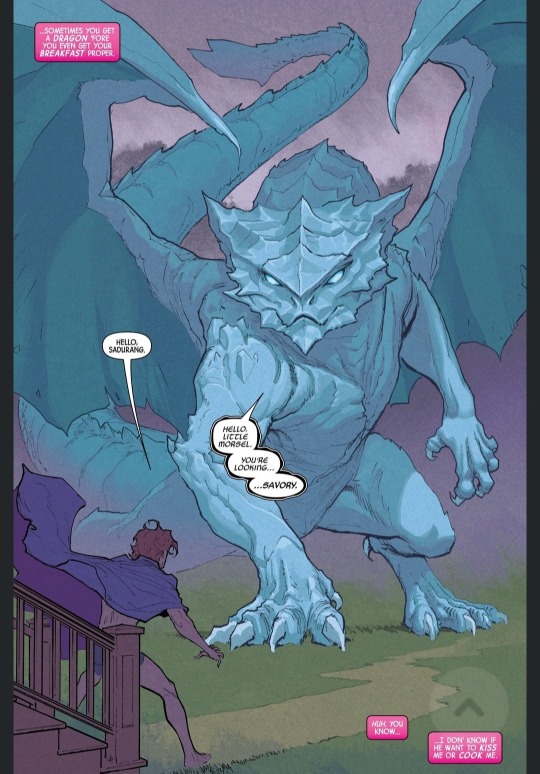
Loving the makeover, dude. Ice suits you
Gambit can't sleep in part because Rogue steals all the blankets. They're both cold. Sadurang the God Snake showing up might have something to do with that - it's not explicit, but Gambit suggested he fuck off to Antarctica when they first met and it seems he did just that. Gambit has been using the Eye of Agamotto he stole to blast children and teleport around, but Sadurang doesn't seem to mind right now. Or does he? Feels like he's kinda hitting on Remy a little bit tbh.
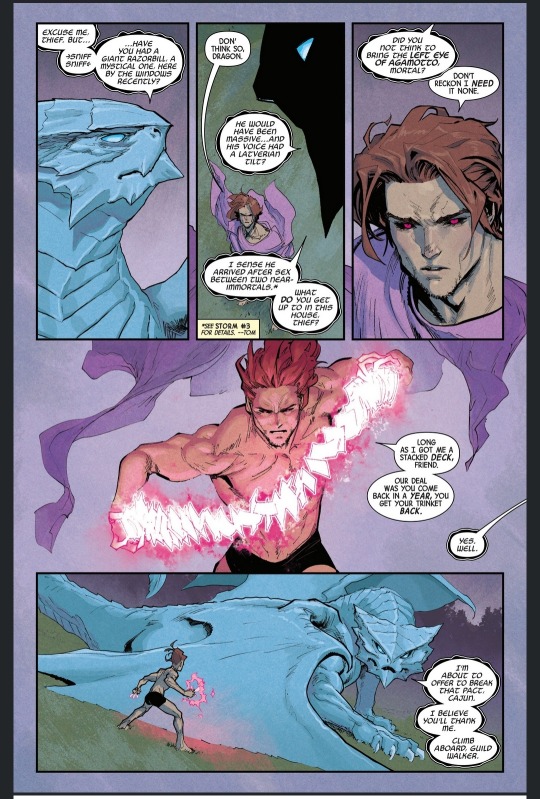
Logan and Sadurang should have a sniff off
He's got questions - very personal and specific questions. 'Where's the bird, thief? You harbouring giant Latverian birds here? I'm asking questions I know the answer to but srsly, spill the tea bestie.' Mind your own business, buddy.
Gambit has no idea what he's talking about, and probably doesn't know about near-immortals fucking either. After Storm and Logan banged, DOOM sent a giant bird to talk to her. Sadurang doesn't really care, it seems he was just making conversation as befits la noblesse oblige. No idea where Gambit kept got those cards from seeing as he's only wearing underpants, but the dragon isn't here to fight. Gambit hops on his back and they fly away. It's refreshing to revisit a plot point that's actually been set-up instead of just springing out of nowhere - I was wondering if we'd truly have to wait a year for his promised return. It seems not, the perceptive icy weirdo has a proposal.

This is Miss Henrietta Benjamin, or Henry. She's a schoolteacher from Chicago who's a mutant and she's leaving for Louisiana to fulfill a duty - and putting her mother, also a mutant - to rest is part of it. Markers of segregation and systems of black solidarity are everywhere, though it's difficult to tell whether the marks she's making are mutant-related or a system of pictorial communication for black folks. Underground railroad code-style. I was only aware of this stuff through the Hobo Code and Skyrim, though pictographic code is much older than that. I assume it's the latter, but the 'Midnight Bark/M' is used in a few pages which confuses the subject. Could be both.
I did quite a bit of research for this (which is why it's later than usual), as the US history we do learn in Australia is about as accurate as our own black history - not very. We pretend to be post-colonial when we're anything but. I want to say it's the 1920s, though I'm going to miss a lot of context. I feel like I should say that upfront - plus I don't want to speak over or for black voices. Henry is seemingly heading to set up the Outliers plot, which promises to be important to mutant history.
I think if you're going to explore (three) hundred year old mutant lore (as has been done before,) striving for authenticity by telling it through black POV has a lot of merit. Uncanny is occasionally a Southern Gothic book, and I'm interested to learn why a young black woman would head south when when black folks were migrating north en masse (The Great Migration) in response to much harsher laws and extralegal discriminatory practices. X-Men has a reputation for diversity, but honestly it's pretty damn white if you look at the numbers, the leadership, and definitely the creators. Uncanny is more diverse than usual, though the 2D black villain that is the Podcaster makes no attempt at exploring the dissonance of her behaviour and motivations intersectionally.
It's a positive thing to have minorities in fiction that aren't solely defined by that, though Warden Corrina Ellis in particular is a visible black woman operating a monument to mutant oppression that she built. Before that she hosted a popular anti-mutant podcast and got a prominent government contract off the back of that. The tactics she's using to systematically break the will of an outgroup - torture, dehumanisation, brainwashing, indefinite imprisonment, even chattel slavery (she was going to sell Beast and did sell Calico) and legal indentured servitude - it beggars belief that she wouldn't have complicated feelings or delusions about what she's doing. Her blackness is kinda relevant and the absence of any depth so far certainly makes me ... vigilant. Wary.

There's a lot of potential for exploring black history and the mutant metaphor but there's also a great many potential pitfalls, something Marvel in general doesn't have the greatest track record with. Much has been made of the 1963 run being inspired by the Civil Rights movement, but I don't buy it because it's not on the page at all. 6 white people with wealth who collaborate with the establishment and use force to keep other mutants in line - I don't see it. Marvel is historically super white and clumsy at best with matters of race. It's not a coincidence that Kitty Pryde has dropped the N bomb 3 times over the years. This history doesn't mean that the mutant metaphor and segregation can't be done well together, or at least inoffensively, but it's all in the execution.
Henry's train ride is uneventful but for a black conductor making the 'Midnight M' signal several times, which she ignores. She can't take the risk that he works for The Service, a nebulous group of mutant hunters. I've been iffy on the M as a modern invention, but it being a known quantity a hundred years ago (exclusively amongst black folks so far) suggests it's a contemporary appropriation or revitalisation. It ties the signal to a significant and specific time in history, which I'm honestly not sure how I feel about. Henry refers to the (Dark) Artery in Louisiana as her duty - interring her deceased mother with 'their kind.'

I didn't have space for pics of most of the Outliers adventure - Ransom is woken up by Deathdream's hand over his mouth and he wigs out. Deathdream gathered all the Outliers, but no adults, to go to the Dark Artery right now. He doesn't really explain that, just says spooky shit and speculates that this is what called them here. We find out it's a graveyard, so I assume Deathdream is communicating with the dead, or they him. Calico especially is scared and Ransom assures her she can sit this out if she wants. She has a crisis of identity, so the others assure her she's a mutant. With that, she's committed. Acceptance and validation from the outgroup/community you're connected to is important, especially for young people. Given her upbringing, I think it's realistic that she keeps backsliding and retreating to her mother's awful mantras. Her initial acceptance happened way too easily after Gambit's 3 panel pep talk, so I enjoy that it's an ongoing process for the most sheltered and socially privileged of the group.
Marcus St Junior and Alice watch them go and clearly know something about the 'door' or Dark Artery. That they're black people who own/run Haven, Henry's destination, suggests a historical link of some kind. Maybe. Probably. Alice seems concerned while Marcus leaves it in the hands of 'our Father' - most likely God, but it often pays to note exact wording. Henry came here for her parent, so a family connection is possible. Either seems reasonable, though if Alice has a reason to be concerned maybe they should be accompanied by the adults whose care they're in? Simone has a Raid on Graymalkin - four issues to tell this story, so we shall see.

Meanwhile, one of the aforementioned adults has been dropped in The Savage Land by Sadurang. Gambit is still without britches, so it's a good thing Marcus doesn't know. Haven has a couple of rules - everyone pitches in, the kids go to school (maybe it's the holidays,) and wear fucking pants. It's come up more than you'd think.
Sadurang is unimpressed with Gambit's efforts to take down a Tyrannosaurus Rex (or an Allosaur maybe, idk) and steps in. It doesn't do much so Gambit blows it up in an act of ecological crime. I have it on good authority that the Savage Land is a protected ecosystem. Lucky Ka-Zar or the RSPCD aren't around - Sauron would certainly object too.

The big cold snake says he admires Remy because they're alike. Feels like a backhanded compliment, or at least a manipulative way to build rapport. He calls him 'admirable' for not wanting to kill the dinosaur - admirable like he used to be. As if to demonstrate, he asks Remy if he objects to eating the dead dino, which he obviously doesn't.
Apparently the Eye of Agamotto (the left one at least) makes you crave flesh. Animals at first, then people, those closest to you. Sadurang will generously take the Eye back, sparing Remy this fate but it's a one time deal. Choose now! Limited time offer. This feels like a scam, lol. He politely asked if he could eat a dead dinosaur, which is probably what dragons do anyway - eat stuff. Agamotto has shown up here and there and we saw no evidence of cannibalism. Doctor Strange has worn one of his other eyes for decades (there are 3,) as have previous Sorcerers Supreme. This Eye certainly does different tricks even for the untrained Gambit. Portals aren't new though randomly blasting people is. This curse or whatever would also be new. It doesn't mean he's lying, necessarily, but it feels like he is. Sadurang was going to come and get it in a year anyway, so it's blatantly not a one time deal. We don't know what Gambit chooses, but I suspect he'll give it up and really need it later or something. We shall see.

Henry arrives in New Orleans and looks to continue on to Haven ASAP. A local porter gives her the lowdown on what's safe and allowed for black folks, but they're interrupted by Jacob Miller from The Service. He's either been following her or had eyes on the train because he questions her about the M, calling it a 'hex sign.' Dude probably was with The Service too. They duel with courtesy and innuendo but Henry's a sharp customer.
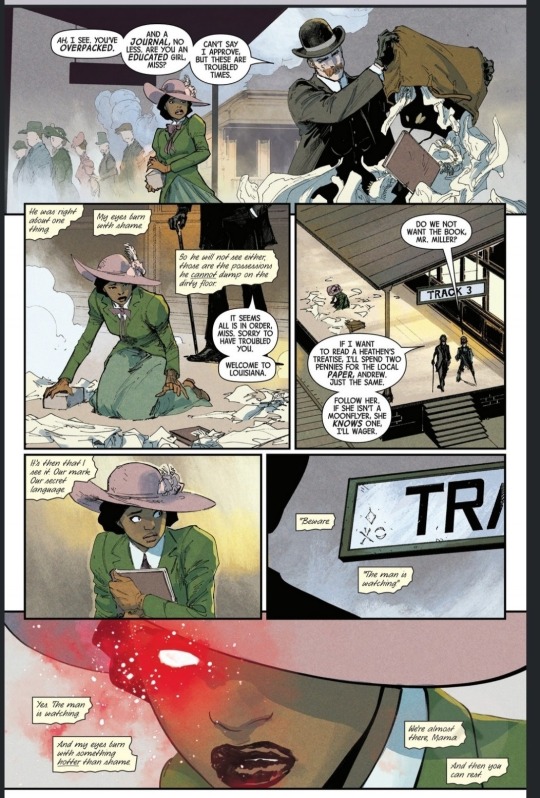
Miller offers to carry her bag, not taking no for an answer, then rips it open. She has bricks and a journal in there, neither of which interest him. He doesn't approve of her being educated/able to write - as a black woman it could be either or both - but he arrogantly doesn't read it. As he bids her goodbye with false politeness he instructs his partner/subordinate to follow her. He sucks.
'If she isn't a moonflyer she knows one, I'll wager' - suggesting that The Service are mutant hunters, proto-Purifiers perhaps - while introducing a new old mutant slur (alongside 'Johnny Devils' and 'abbhorences.') Henry notices a mark meaning 'beware' on the train station sign. Her eye glows red, Cyclops style, as she affirms that The Man is watching while vowing that they're almost there and her mother can rest soon. Her thoughts are stylised as journal entries,with the framing of her writing this letter about past events.
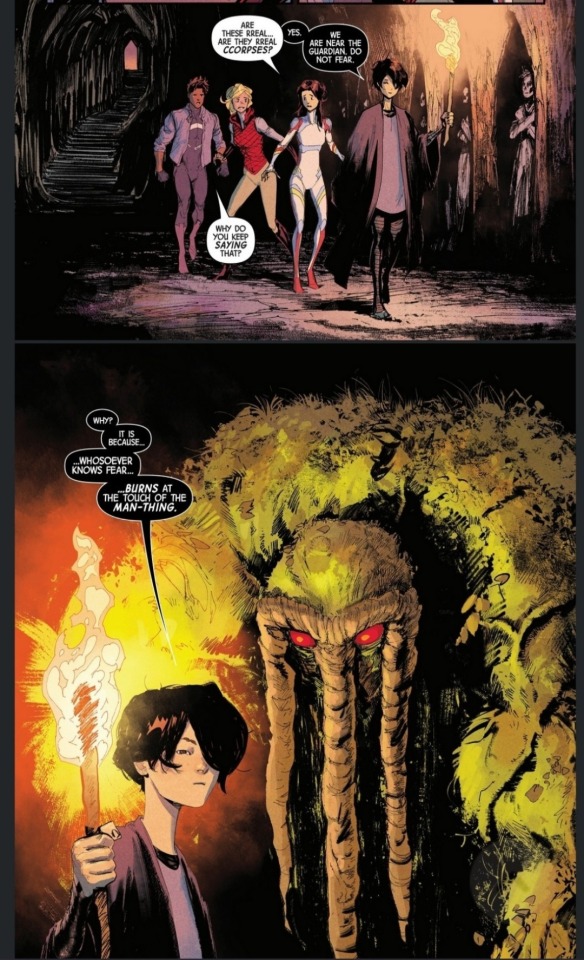
The issue ends on the Outliers reaching their destination - a circular room with coffins laid out neatly. A graveyard underneath a swamp, as Calico says. Ransom picks up a book from the centre of the room that's not a match for Henry's diary, and there's torches burning. Deathdream confidently states that they've been doing so for 300 years, but offers no explanation for how he knows that. 300 years is a long time - whatever this is would have been established for 200 years before Miss Henrietta Benjamin made her journey. The French founded New Orleans in 1820, so we're talking early or even pre white history in the region. There's a Latin carving inscription on the wall that Jitter translates as 'bring us your own to rest forever.' Everyone except Deathdream is spooked, and he repeatedly tells them to not be afraid. They literally walk past interred bodies standing up with their arms crossed. It's objectively scary.
The cliffhanger is that this place is guarded by the Man-Thing. Deathdream is characteristically calm while the others are not. Hopefully they can overcome that, or not get touched by The Man-Thing, because nobody wants to burn. Most people, anyway. I am not a Man-Thing expert, though I do know that he guards The Nexus of All Realities in Florida, and has only been doing so since ~the sixties. This doesn't look like the Nexus of All Realities or Florida, but that's a mystery for next issue.
Uncanny X-Men #13 is all questions and set-up, but it passes a vibe check for a Southern Gothic mystery from history. It's a little railroady in that all characters spend the time travelling to a place and just arrive there, but there wouldn't be room for much more without cutting the Gambit plot. It didn't seem to have much to do with the A and B plots in different time periods - which is fine - it just distracts from the definitely connected journeys of Henry and The Outliers. It's a little jarring to cut from Southern Gothic to dinosaurs in the Savage Land, but it's part 1 of 4, so they may well be connected. Right now I'd prefer the other plots be more fleshed out, but I suppose it's a good thing to leave us wanting more.
It's certainly ambitious in its scope and I'm invested in the mystery that's being built here. I'm happy to say it feels like Simone is hitting her stride, leaning into the setup without replaying Rogue angst beats or having to worry about Xavier's dense gravity pulling the characters into his orbit. The issues I do have are caused by infrastructure - the book has a lot of characters and Jubilee and Kurt especially feel like NPCs. Marcus and Alice just watching the kids head into a swamp underscores their position as passive characters, but that's okay right now. Aside from doing a bottle episode, there's no way around that, so playing the cards as they lay and centering The Outliers is a strong move.
Dark Artery part 1 feels like a strong start for four parter, and for the first time I'm delighted to say that this issue is worth reading. A good issue even, with more of the elements I like and less of the undeveloped fluff. Henry is a mystery with some pretty big hints and The Outliers' Scooby Doo-ing Southern Gothic feels organic with me asking 'what's next?' I've been harah on this book, which I don't apologise for, but fair is fair. #13 is solid.
#x men#x comics#uncanny x men#gambit#the outliers#deathdream#jitter#calico#ransom#Henrietta Benjamin#reconstruction#marvel#comics#Sadurang#eye of agamotto#the savage land#review#from the ashes#gail simone#man thing
22 notes
·
View notes
Photo

Raiders, Rulers, and Traders: The Horse and the Rise of Empires
Chaffetz deftly illustrates the vast history of Asia and its great empires -- Chinese, Persian, Indian, and Mongol -- through a history of horsepower. The cultures of the people of the steppe, their religions, technology, and migrations also come into play. Expertly, Chaffetz shows that horse breeding and trading, not the fabled Silk Road, linked these historical forces together over time and distance.
The Silk Road may have carried the world’s most luxurious fabrics for trade, but it was paved with horses’ hooves. From the Bronze Age to the 20th century, the empires of China, Persia, India, and Mongolia conquered astride the backs of horses. By focusing on the history of the horse in Raiders, Rulers, and Traders, David Chaffetz provides fascinating insights into conquests in history, from the Persian Empire of Cyrus the Great to the Russian Empire of Alexander II.
Chaffetz traces the evolution of the horse from a wild animal of the Eurasian steppe to its place at the center of war and commerce over almost 3,000 years of human history. The earliest horses weren’t much larger than donkeys. He shows that the first domesticated horses pulled carts and chariots — as it took centuries of breeding until they were strong enough to carry humans. The breeds of horses reflected the cultures that adopted them: the sleek, speedy raiders of Arabia; the huge, powerful Persian steeds; and the sturdy Mongol breeds whose endurance and ability to thrive in harsh conditions were key to Ghengis Khan’s continent-spanning conquests. Maps of the Eurasian Steppe in every chapter help readers to keep track of the disparate locations, and illustrations show the artifacts that these cultures created to celebrate horsemanship.
Of the empires covered in the book, China gets a special focus. The Great Wall was built by the Qin Dynasty in the 2nd century BCE to protect the northern frontier from horse-mounted raiders. Yet China needed horses for its own armies, and large-scale horse breeding was difficult in the hills and fertile valleys south of the wall. A sophisticated trading network grew along the frontier in which trade goods like silk and tea were traded were exchanged for animals.
The Silk Road grew in the wake of a 1st-century BCE military expedition led by the Hun general, Li Guan Li, to find the “blood-sweating” Ferghana horses that nomads had described to Chinese horse traders. Braving high mountain passes and arid wastes in a journey that presaged those of Coronado and Lewis & Clark in North America, Li laid siege to a citadel near the present-day Kyrgyz city of Aravan. His reward was 300 of these “celestial horses” along with a promise of 2 horses every year thereafter. These yearly journeys, and the return of payments of silk and other commodities, established the Silk Road.
Indian emperors also relied on imported horses from central Asia. In a region whose jungles and deserts were unsuitable for breeding horses, huge trade fairs arose across India, where rajas met Afghani horse breeders to do business. Like China, India faced waves of horse-borne invaders from Afghanistan and Persia. As the sea trade with Arabia and, later, Europe developed, southern Indian rulers gained key means to defend their lands.
Horsepower remained the key to empires into the dawn of the 20th century, during which gasoline-powered vehicles arose. In later chapters Chaffetz covers Britain’s strained efforts to breed horses in India – and strike deals with Afthani traders – as well as the Russian Empire’s use of cossack cavalries to conquer the steppe.
In appendices, Chaffetz details the prices of horses in China and India in both historic and present-day terms. A timeline connects concurrent developments in the Western Steppe (Persia) the Indian Subcontinent and the Eastern Steppe.
Chaffetz writes frequently for publications like Asian Review of Books and is a member of the Royal Society for Asian Affairs. Raiders, Rulers, and Traders is a broad history that will augment readers’ knowledge of the great empires of Asia. Its focus on horse husbandry is a useful gateway into history for reluctant learners.
Continue reading...
18 notes
·
View notes
Text
most romani rights campaigns are EU projects and like half romani groups are EU-affiliated orgs and this is never gonna work because the EU is all about promoting defending and expanding the free market and free market policies have always put romani people at a disadvantage like intensifying the concurrence between workers + letting private companies pretty much do what they want with their workers while wages are so low and prices are rising and labour rights are under attack; all these things are obviously harder on the romani population considering 80% of european romani people live below the poverty line and many romani communities are segregated in eastern europe in particular. let's be real here the whole EU goal is to lock romani ppl (and in particular romani migrants from eastern europe) in the lowest part of the working class! not to mention liberalizing migration flows the way it's currently being done in western europe just puts migrant people in a very precarious and lbr inhumane situation while at the same time doing nothing to prevent human and sex trafficking where romani people (and women in particular) are over-represented as victims. anyway this is my thesis
12 notes
·
View notes
Text
Even as a growing number of foreign governments commit to protecting the rights of lesbian, gay, bisexual, transgender, queer, and intersex (LGBTQI+) people, others are actively marshaling their resources against them. From the Hungarian government’s legal and political attacks on LGBTQI+ people to Iraqi legislation that punishes those who “promote homosexuality” and increases criminal penalties and fines for same-sex relations, the negative trends are significant and concerning.
In many places, politicians blame LGBTQI+ people for a wide array of societal ills to boost their popularity at home and their geopolitical interests abroad, distracting from the real economic, social, and political challenges their countries face. In Georgia, for example, the ruling party may have used anti-LGBTQI+ rhetoric to manipulate the political landscape ahead of elections. Meanwhile, in Lebanon, a country long considered relatively welcoming for LGBTQI+ people in the Middle East, one activist described a political leader’s rhetoric as “the manufacturing of a moral panic in order to justify a crackdown, and to deviate public attention away from their unpopular policies.”
Although human rights are seen by some as a lower-priority foreign-policy issue for the United States than so-called hard security threats, the failure to protect them abroad can have significant negative consequences for U.S. interests. Now more than ever, the United States needs to push back against foreign-government repression of LGBTQI+ rights while also doing this work at home. As U.S. Secretary of State Antony Blinken put it recently, this matters “not just because we have a moral imperative to do so,” but because doing so “helps strengthen democracy, bolster national security, and promote global health and economic development.”
Across a range of issues, it’s clear that anti-LGBTQI+ policies and rhetoric can cause significant damage to many of the United States’ top foreign-policy priorities.
To start, efforts to repress LGBTQI+ rights are often a canary in the coal mine for more severe persecution to come. A 2022 report found, for example: “From Nazi Germany to genocide in Darfur to the breakup of former Yugoslavia, the imposition of ‘moral’ codes that directly assault sexual and gender identities and freedoms came before widespread state-led physical violence and atrocity crimes.”
The targeting of LGBTQI+ people can also be a precursor to, or occur alongside, abuses against other vulnerable populations. The Taliban-promoted sexual assault of and life-threatening attacks on LGBTQI+ people, for example, have occurred concurrently with brutal restrictions on women’s and girls’ participation in education, work, and other aspects of public life. Likewise, vicious torture of gay men in the Russian Republic of Chechnya has taken place against a wider backdrop of long-term human rights abuses by Chechen authorities.
Erosion of LGBTQI+ human rights can also signal and exacerbate the breakdown of democratic norms and institutions, including restrictions on independent media and judicial review, serving as a bellwether for the state of civil society more generally. Russia’s recent detention and prosecution of LGBTQI+ people have paralleled its crackdown on independent journalists, human rights defenders, and civil society.
Countries in which the human rights of LGBTQI+ people are less respected also frequently have greater levels of corruption, partly because discriminatory legal regimes create barriers to reporting wrongdoing by corrupt officials, making LGBTQI+ people an easy target for extortion. Corruption, in turn, compounds other pressing problems: It degrades the business environment, drives migration, and impedes responses to public health crises and climate change. States with endemic corruption are also more vulnerable to terrorist networks, transnational organized crime, gang-related criminal actors, and human traffickers. This is, in part, because threats to transparent and accountable governance are among the root causes of radicalization, and restrictions on LGBTQI+ and other civil society organizations reduce the capacity of those groups to mitigate the conditions conducive to violent extremism, terrorism and other criminal activity.
Not only are anti-LGBTQI+ policies a drag on economic growth, but they are also detrimental to public health. Punitive laws fan the flames of stigma and discrimination, in turn making vulnerable communities reluctant to seek life-saving and public health-protecting services. Across 10 countries in Sub-Saharan Africa, for example, HIV prevalence in countries that criminalize homosexuality is five times higher among men who have sex with men than in countries without those laws.
Taken together, the failure to protect LGBTQI+ people’s human rights can create disastrous effects for U.S. interests. State-sponsored discrimination and violence undercut the United States’ tremendous investments in international anti-corruption efforts, counter-terrorism programs, economic development, and public health. And, as the COVID-19 pandemic made clear, a disease threat anywhere can quickly become a disease threat everywhere. The same can be said for terrorism, corruption, and economic instability. When governments target LGBTQI+ people, they also increase the chances that the symptoms and consequences of this repression will spread in their communities and across borders.
Given the stakes, it is crucial that the United States uses the tools and powers it has to promote accountability for human rights abuses and mitigate their harms to U.S. citizens and businesses.
In this respect, the recent heightened repression by the Ugandan government is illustrative. In May 2023, Uganda signed into law the Anti-Homosexuality Act (AHA), which mandated the death penalty for certain “serial” offenses and a 20-year prison sentence for the mere “promotion” of homosexuality. Although the legislation was decried by human rights advocates, it was lauded by some of Uganda’s geopolitical partners as evidence of shared interests. Shortly after the legislation was passed, the late Iranian President Ebrahim Raisi visited Uganda and made the unfortunately common—and demonstrably inaccurate—claim that homosexuality is a Western import. He also identified opposition to Western support for LGBTQI+ people as “another area of cooperation for Iran and Uganda.” In similar fashion, an editorial on the pro-Kremlin Tsargrad website summarized the law as “a geopolitical victory [for Russia], which they see as the direct result of years of their hard, methodical work [on a] global anti-LGBTQ hate campaign.”
The AHA was the final, egregious straw amid an ongoing decline in respect for human rights, including of LGBTQI+ people, and democratic backsliding in Uganda, and the United States’ response was swift and comprehensive. Underscoring the link between the violation of the human rights of LGBTQI+ people and broader harms to American interests, U.S. President Joe Biden described the law as part of an “alarming trend of human rights abuses and corruption.” The United States issued a business advisory; updated the U.S. Travel Advisory and Country Information Page for Uganda; expanded existing visa restrictions to include those repressing vulnerable populations, such as human rights advocates, LGBTQI+ people, and environmental defenders; supported the World Bank’s decision to pause Uganda’s access to new funds; and imposed sanctions on the Commissioner General of the Uganda Prisons Service for widespread violations of human rights, including credible reports of physical abuse of political opposition and LGBTQI+ people. President Biden also determined that Uganda did not meet the eligibility requirements of the African Growth and Opportunity Act (AGOA), “on the basis of gross violations of internationally recognized human rights.”
Although the law remains in place, these actions and international attention have had effect: Uganda’s government has not conducted widespread roundups of or ordered death sentences against LGBTQI+ people. But violence, abuse, and evictions have increased in the country, and arrests of LGBTQI+ people have persisted and likely risen under an earlier, colonial-era law that criminalizes same-sex conduct.
As the situation in Uganda demonstrates, the United States has options to respond to foreign governments that fail to uphold their human rights obligations. These measures can be unilateral, as is the case for issuing travel advisories or removing trade preferences, or multilateral, which could involve working with the United Nations, the World Bank, or other multilateral institutions. They can also be affirmative, as opposed to punitive—for instance, expanding humanitarian and development assistance for human rights defenders and mobilizing private sector capital to support businesses that operate consistent with international non-discrimination standards.
As with all diplomatic efforts to address wrongdoing, the choice among these options will vary depending on circumstances, such as whether a government is launching a new campaign against LGBTQI+ people or has an older but little-enforced criminal law on its books. Inevitably, the importance of raising human rights concerns will be weighed against other U.S. priorities, and human rights will not always prevail. However, increasingly, LGBTQI+ issues are being integrated into bilateral relationships, even when doing so is not easy and when quiet diplomacy is the only option. In all circumstances, consultation with LGBTQI+ civil society must be prioritized in weighing the benefits and risks of action to ensure that efforts do not contribute to backlash or negative repercussions for LGBTQI+ people on the frontlines of global human rights movements.
In a recent State Department convening on LGBTQI+ rights in U.S. foreign policy, Secretary Blinken made our commitment clear, telling civil society leaders: “Our promise is this: We will be with you every step of the way. We’ll persevere with you. We’ll listen to you. We’ll learn from you. We’ll help resource and support your fight. And we’ll bring our strength together with yours so that finally together we can build a world where all people are genuinely free—free to be who they are, free to love who they love.”
Although this work may have been in the spotlight during Pride month, it requires our focus year-round. Indeed, our national security depends on it.
26 notes
·
View notes
Text
How do you make a whore moan?
Extract sapogenins from a Mexican yam and employ Marker degradation to degrade the sapogenin side chain while leaving similar functional groups on the steroid nucleus (relatively) unaffected. Use acetic anhydride to block the hydroxyl group formed by opening the six-membered pyran ring. Then oxidatively open the five-membered furan ring with chromic acid. This forms the acetyl side chain of progesterone and an esterified hydroxyl group on the steroid nucleus. The ester is then hydrolyzed under strongly basic conditions. The use of acetic acid leads to the production of 16-dehydropregnenolone acetate (16-DPA). 16-DP can be converted into progesterone in two steps. Firstly, the double bond in ring D is hydrogenated, followed by Oppenauer oxidation of the hydroxyl group and the concurrent migration of the remaining olefin from ring B to ring A so that it is in conjugation with the ketone carbonyl group at position 3. Alternatively, a three-step procedure involving Br2, CrO3, and Zn/HOAc can be used. 16-DP can also be converted into testosterone and the downstream products estrone and estradiol. 👍
#jokes#funny#lmao#lol#monday giggles#teehee moment#humour#comedic#thoughtful humour#joke of the day#classic laughs#silly#goofs#entertaining#lighthearted#share if you chuckled#laughter provoking#witty#the lighter side of life#guffaw daily#hilarious#amusing stuff#rofl#lmbo#droll#merriments#jestercore#weekday smiles#laughter is the best medicine#grin and the world grins back
20 notes
·
View notes
Note
What's so annoying about this constant uwu I'm baby leftist refrain of "just because you're indigenous to a place doesn't mean you have the right to displace people" that's coming from goyim and antizionist self hating Jews alike is that... Jews decolonizing Eretz Yisrael did not have to displace anyone. That was never the intended goal of even the most conservative, if you can call them this, racist Zionist leaders?
Jews resettling our homeland en masse does not fucking mean displacing anyone. These are two separate events. And blaming Jewish immigration for the displacement of Arabs is ignorant at best. It's a clear red flag they don't know the complexities of the Nakba, the different (if concurrent) factors for different groups of Palestinians to flee or be forced out in waves.
In any event, had Palestine accepted the partition plan, no displacement would have occurred. No war = no ethnic cleansing. Even though Jewish communities were routinely destroyed leading up to the partition, there still was no general will to cleanse the land of Palestinians among Jews. Many of the 750,000 Palestinians were displaced as a military exigency by a nascent Israel. This would not have occurred had the partition plan gone as intended. This would not have occurred had their been no partition plan at all.
Jewish resettlement =/= cleansing Arabs.
And at worst, acting like Jewish decolonization itself is an act of displacement, that all this was inevitable because of the mere presence of Jews increasing in Palestine, or some character of ~European~ Kha- I mean- Jew-ish people, or that their was some secret Zionist committee who all got together to drink blood in their Bank Palaces and circle jerked at the idea of cleansing Palestine... I mean then you're just antisemitic. Jews moving anywhere is not a crime, it is not a plague, it is not a humanitarian catastrophe. Jews should not be barred from any country. Human migration, at least when it's not military and financially expediated by an imperial power, is never immoral.
I don't think the Ottomans resettling Circassians and Balkan Muslims in the region was bad. I don't think Egyptians and other Arabs immigrating to Palestine in the 19th century was bad. The pro Palestinian side denies that these groups even came to Palestine, but if they were forced to acknowledge it, I doubt they would say they were displacing the totally real and indigenous Palestinian People? Probably because Arabs/Muslims are granted inherent legitimacy to them. This was always about "The Ummah 💪" to them. A Malaysian has more of a right to live in Palestine than a Jew from the Old Yishuv. They just hate Jews.
The Jewish resettlers built towns on empty land. They bought as much land as they could legally from the Ottomans. There were zero pogroms against Arab communities. There was space and economic opportunity for Jews and Arabs alike, and every Zionist leader acknowledged this. Does this mean everything was perfect and the Jews were totally faultless? Of course not. But the Zionists set out with a clear code of conduct for Zionism to occur. This is historical fact.
Even if not all of the 750,000 Palestinians who became refugees were specifically cleansed by the proto IDF, 200,000 or so people being cleansed is still a crime against humanity. Almost a million people fleeing their country at once is still a tragedy. But this was not an inevitable and direct consequence of Jews rebuilding Israel. There is a timeline where Zionism still occurred and was successful, and no Nakba occurred. This was 100% always a possible outcome.
Insisting otherwise means you think Zionism itself is a genocidal colonial mindset, which clearly all these people do believe wholeheartedly. But we'll never get anywhere as long as people don't recognize the umbrella of connotations and ideas that Zionism held and still holds. We'll never get anywhere while people still treat Jews living in our homeland as foreign suspicious duplicitous dangerous interlopers. Why should Jews come to the table if we're treated as the enemy no matter what? If the very core of Israeli identity is treated as rotten and not worthy of, not just respect, but life?
Excellent points throughout!
Retconning Zionism into being only about refugee displacement is also done to stifle discussion of the partition plans of 1947 (or 1937). Palestiners want to have their cake and eat it too - nonstop crying over the decisions of 1940s Jews, disregard and denialism of those of 1940s Arabs. The talking point is always "Why should they have given an equal share of the land / the best land / ANY land to new immigrants?" Funny how Jewish immigration was such a threat that it was perfectly understandable and natural for Arabs to riot and massacre to make it stop, yet not enough of a threat to consider that maybe it would get bigger and that a negotiated compromise would be a good idea. The only thought, the only goal, was killing.
(Similar: "there can't be a 2SS because of the settlers, let's make a 1SS" - the settlers would still be there in a 1SS, so they aren't the block. The block is refusing to allow for any Israel at all. Winning is the Jews losing.)
125 notes
·
View notes
Text
The Crossroads of Youth
It is important to recognize that "The Crossroads of Youth" and "Turning Point of the Youngsters" are two translations of the same Korean title, "청춘의 십자로." For clarity, this post will consistently refer to the film as "The Crossroads of Youth." Enjoy.
"The Crossroads of Youth" (청춘의 십자로; 靑春의 十字路) is a melodrama film from 1934, produced during the Japanese colonial era in Korea. Directed and written by Ahn Jong-hwa, the film features performances by Lee Won-yong, Shin Il-sun, Kim Yeon-sil, and Park Yeon. Notably, it predates Korea's first sound film, "The Story of Chunhyang," and is recognized as the sole surviving silent film from this period, classified as National Registered Cultural Property No. 488. The narrative follows the experiences of a protagonist who migrates from the countryside to the capital. Initially considered a lost film, its original version was rediscovered in 2007 and subsequently released in 2008, albeit with some unrestored segments.
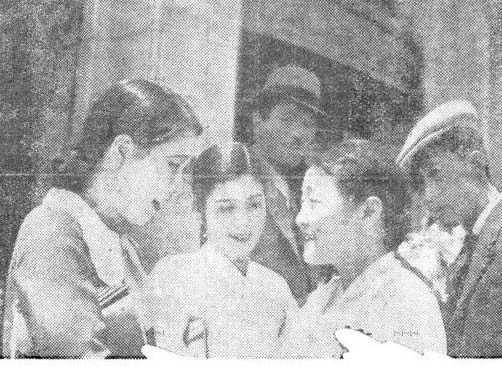
A scene from the 1934 film Crossroads of Youth silent film
Directed by Lee Gyu-seol (이규설) Cinematography by Lee Myeong-woo
Supervision, Script and Editing by Jong-Hwa Ahn (안정화)
Production Company - Geumgang Cinema (금강키네마)
Opening Date - September 21, 1934 at the Chosun Theatre (조선극장)
Movie Duration - 73 - 80 Minutes
Nation - Japanese colonial period Joseon during the Japanese colonial period.
Language - Silent Film/ Korean Commentary
Cast:
Lee Won-yong (이원용) – played Yeong-bok (영복)
Shin Il-seon (신일선) – played Yeong-ok (영옥)
Park Yeon (박연) – played Jang Gae-cheol (장개철)
Kim Yeon-sil (김연실) – played Young-hee (영희) (Some say it is Gye-sun, not Yeong-hee)
Yang cheol (양철) – played Ju Myeong-gu (주명구)
Moon Kyung-shim (문경심) – played Bong-seon (봉선)
Lee Bog bon (이복본) – played Baggage Carrier Friend (수화물 운반부 친구)
Choi Myung-hwa (최명화) – played Baggage Carrier Friend (수화물 운반부 친구)
Plot
The film opens with the sight of a train passing, setting the stage for Young-bok's journey. Having left his mother and younger sister, Young-ok, in their hometown, he arrives in Seoul to work as a porter at Gyeongseong Station. Previously, Young-bok spent seven years as a son-in-law at Bong-seon's household, but he relocated to the city after Bong-seon was taken by Ju Myeong-gu. In his new role, he encounters Young-hee, a gas station attendant who struggles to support her ailing father and younger sibling.
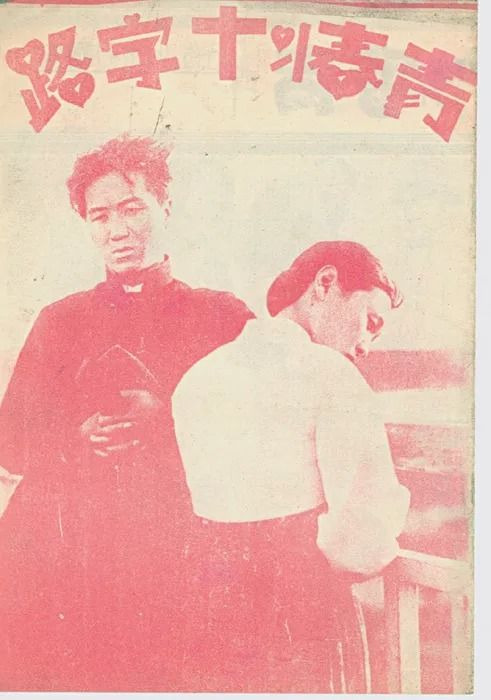
In the meantime, Young-ok, having lost her mother, travels to Gyeongseong in search of her brother. Unable to locate him, she secures a position as a waitress at a café. During her employment, she meets Gae-cheol, a wealthy associate of Ju Myeong-gu, who exploits her vulnerability, leading to a traumatic encounter. Concurrently, Young-hee, who has also lost her job, becomes ensnared in Gae-cheol's predatory circle.
After fleeing her home, Young-hee confides in Young-bok about the harrowing events. Upon learning the truth, Young-bok confronts Gae-cheol at his residence, where he reunites with Young-ok. She recounts her ordeal, prompting Young-bok to seek vengeance against Gae-cheol. In a climactic confrontation, he and his fellow porters launch an attack on Gae-cheol and Ju Myeong-gu's gang. Ultimately, with the conflict resolved, Young-bok receives Young-ok's blessing and vows to start anew alongside Young-hee.
Production
"Crossroads of Youth" marked the inaugural production of Geumgang Cinema, a film production entity. Initially conceived as a sound film, the decision was made to transition to a silent format due to certain deficiencies identified in the original footage. Producer Park Chang-soo, who adopted the stage name Park Yeon for his role as Jang Gae-cheol, financed the project himself after experiencing setbacks in his acting career, including an unsuccessful audition for actor recruitment.
The filming took place across various locations in Gyeongseong. The narrative commences at Gyeongseong Station, where the character Yeongbok serves as a porter, while scenes featuring Yeonghee as a gas station employee were captured in the vicinity of Gyeongseong Station Square. Additionally, a pivotal fight sequence between the characters Banbu and Gookilgwan was filmed in one of Seoul's numerous restaurants.
Screening
"Crossroads of Youth" premiered at the Joseon Theatre on April 21, 1934. On September 26 of the same year, an incident occurred involving an actor from the film who was stabbed. Um Dong-ok (엄동옥; 嚴東鈺), a boxer and gangster known as Shinmajeok, confronted Lee Won-yong and Park Yeon after viewing the film. During this encounter, Um Dong-ok requested a drink, citing the movie's commercial success, and subsequently demanded payment for his suit. When Lee Won-yong refused to comply, Um Dong-ok attacked him with a dagger. The weapon penetrated Lee Won-yong's left abdomen, cutting through his suit jacket and pants, yet fortunately did not injure his flesh.
Excavation and Re-examination
Following the discovery of "Sweet Dream" in 1936, a private collector reached out to the Korean Film Archive, claiming possession of nine rolls of vintage film. The collector explained that his father had operated a cinema named Dansungsa until shortly after the Korean War began, and the films were preserved when the theater ceased operations during the conflict. Upon examination by the Korean Film Archive, it was confirmed that these rolls contained the original negative of "Crossroads of Youth," which premiered in 1934. Notably, the discovered material was a negative rather than a positive print, consisting of nitrate film, with eight rolls representing the main content and one roll dedicated to the ending credits. Regrettably, one of the eight main rolls exhibited a whitening effect, rendering it irreparable.
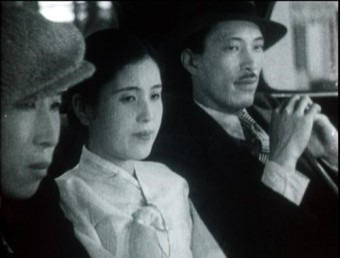
The discovery of this film marked it as the oldest surviving Korean cinematic work, leading to occasional screenings organized by local authorities and film archives. Given its silent film status, many of these screenings featured a narrator to provide context and commentary. In 2007, the Korean Film Archive was approached by another private collector who provided nine nitrate negative rolls from the 1930s. Among these, one roll included the film's concluding titles, while another was too deteriorated to undergo restoration. The collector's father had retained these films from his time managing Dansungsa until the onset of the Korean War.
During the restoration efforts, the film research team initially identified the work as "Passion Flowing Through the Galaxy," directed by Ahn Jong-hwa. However, further investigation clarified that the film was indeed "Crossroads of Youth." This process underscores the challenges associated with preserving nitrate film, which is susceptible to oxidation and poses significant fire hazards, as evidenced by historical incidents even in well-organized archival environments like the United States. The fortunate survival of these films, despite their precarious conditions, is a remarkable achievement in film preservation.
Evaluation
In 1938, the Chosun Ilbo Film Festival recognized "Crossroads of Youth" as the sixth best entry in its list of the "Top 10 Silent Films."
Show
At the time of its debut, "Crossroads of Youth" achieved significant commercial success. Baek Ya-saeng, in his article "15 Years of Joseon Cinema" published in the Chosun Ilbo, remarked that "Mr. Ahn Jong-hwa produced ‘Crossroads of Youth,’ and the audience, eager for Joseon cinema, responded with applause reminiscent of raindrops at a festival." He further noted that during its screening in Daejeon on Chuseok in 1937, three years post-release, the venue was filled to capacity.
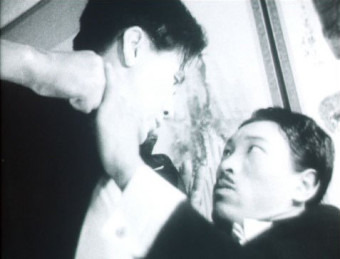
Director Ahn Jong-hwa later reflected on the film's box office performance, attributing its success partly to the return of actors Lee Won-yong and Shin Il-sun to the screen after a lengthy absence, which provided the film with a competitive edge at the box office.
Impact and Value
“Crossroads of Youth” predates the first sound film, “Chunhyangjeon,” released in 1935, and stands as the sole silent film produced during the Japanese colonial era. Its historical significance is underscored by its designation as National Registered Cultural Property No. 488 in South Korea, reflecting its cultural and artistic value.
Film historian Kim Jong-won highlights several aspects of “Crossroads of Youth” that contribute to its importance in Korean cinema. It provides insight into the state of filmmaking at the conclusion of the silent film era under Japanese rule, showcases the talents of early silent film actors like Shin Il-sun, Lee Won-yong, and Kim Yeon-sil, and offers a glimpse into the early works of Ahn Jong-hwa, whose contributions remain largely unexamined due to the loss of his films. Notably, the film's discovery occurred within South Korea, further enhancing its cultural relevance.
youtube
Anseong Art Hall to hold performance of historical drama 'Crossroads of Youth'
Anseong Art Hall in Anseong City set to showcase the historical drama 'Crossroads of Youth' at 7:30 PM on July 28, 2021, in the Small Theatre. This event was part of the hall's programming for Culture Day in July and represents a reinterpretation of the 1934 Korean silent film 'Crossroads of Youth' by Jong-hwa Ahn, presented in a new format known as bensa drama. The performance aimed to evoke the atmosphere of the Gyeongseong theatre district during the 1930s, as articulated through the bensa's dialogue in the original film.
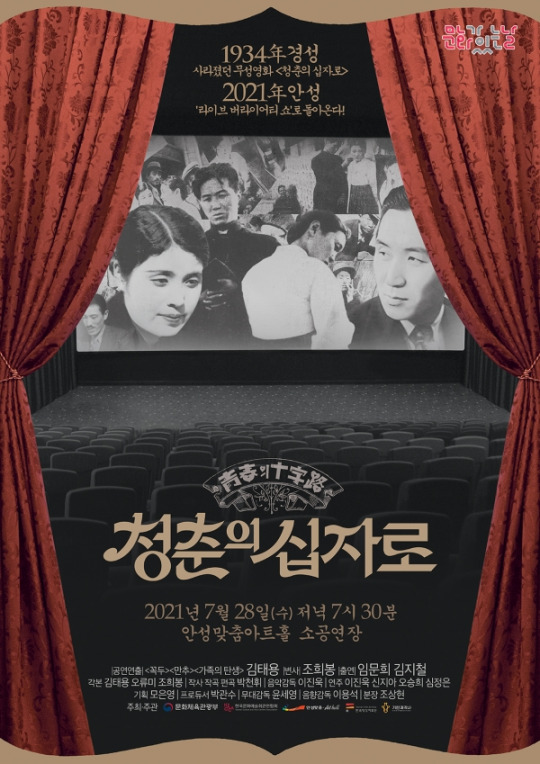
Anseong Art Hall in Anseong City will present the historical drama 'Crossroads of Youth' at 7:30 PM on the 28th as part of the July Culture Day planned performance at the Anseong Art Hall Small Theater. (Photo = Anseong City).
The significance of 'Crossroads of Youth' lies not only in its status as a landmark Korean film but also in its aesthetic and historical value. The film has garnered acclaim for its visual artistry and has been featured in prestigious film festivals, including the Seoul Chungmuro International Film Festival and the Busan International Film Festival in 2008, as well as international events such as the 47th New York Film Festival in 2009 and the Guanajuato International Film Festival in 2011. These accolades have played a crucial role in promoting the global recognition of Korean cinema and its performances.
This production is under the direction of Kim Tae-yong, known for his work on "The Birth of a Family" and "Manchu." Jo Hee-bong, recognized for his roles in "Chuno" and "My Love from the Star," served as the narrator, showcasing his abilities and artistry throughout the performance.
The silent film play "Crossroads of Youth" creatively fills the voids of silent cinema with a blend of humour and wit. Tickets were available for 5,000 won with a 'Culture Day Discount,' and Anseong Art Hall implemented safety measures by limiting attendance to 143 seats, which was under 50% of the venue's small theatre capacity, to mitigate the risk of COVID-19 transmission.
#south korea#korea#The Crossroads of Youth#청춘의 십자로#靑春의 十字路#20s#30s#melodrama#history#youtube#Youtube
7 notes
·
View notes
Text
By E. Jeffrey Ludwig
If President Donald J. Trump is re-elected as our 47th president, we will see the renewal of our economy and social order as he has promised. Tariffs will be raised on goods manufactured abroad by U.S. companies as an incentive to bring the manufacture of those products back to the U.S. Thus, an intentional move to a more protectionist international trade policy will be reinstated as an alternative to the multilateral opening of trade that intensified during the years of the Clinton presidency. Domestic oil production will be incentivized and thus increase, resulting in a concurrent drop in transportation prices, with retail prices in our stores and at our pumps also significantly lowered (although it is doubtful that they will fall back to pre-Biden levels).
Mass migration (first cousin to mass degradation of existing cultural values) at our southern border will be sharply curtailed and “the wall” will be finished. Thus, immigration will be governed by law, not by ideology or political manipulation. As Trump has often said, “It will be a big beautiful wall!” At the same time, we can expect him to keep his promise that we will see the biggest mass deportations ever seen, probably bigger than the ones that occurred during the years of the Eisenhower presidency in the 1950s. If Republicans continue to control the House, it seems likely they will eliminate taxes on tips and on overtime to fulfill his promises in those areas of the economy. In short, there will be an upsurge in prosperity.
As a candidate he has also promised that if elected he will settle the dispute/war between Ukraine and Russia even before he takes office. That has been a bold and challenging claim on his part, and it remains to be seen if the Democrats will challenge his right to enter into such negotiations before he takes office. He has promised that Elon Musk has said he would be able to reduce the budget by $2 trillion dollars a year which is quite a bit, but we would still find our-selves with a national debt that is excessive and troubling.
6 notes
·
View notes
Text
On the Western peninsula Natam, the arrival of Lan Mñats resulted in a shift. By itself Lun Mñats are not very militaristic, but their mounts require grass fields to eat, making them compete for the land with indigenous Sùtòtòm sutviprra for habitat. Also, Lan Mñats tradition of covering themself, hiding all the skin, immediately alienates other non-unzu cultures. The riders arrive either seasonally or stay in one territory for one year, which puts the local ecology in a straign. To protect their animals, Sutviprra kill local predators, while uncontrolled populations of domesticated Mñats eat away at local vegetation. The soil degradation start to creep in, as this area relatively recently was a desert, and the herd animal activity resurfaces all the sand from that time. Such changes prompts Lan Mnats to move further into Dumkatsdoñ, and the Sùtòtòm either militarizing against the Lun Mnats or migrating across the Kùlónsárrèm onto the new territories - islands Josénfústòkn and Jorrfústòkn.
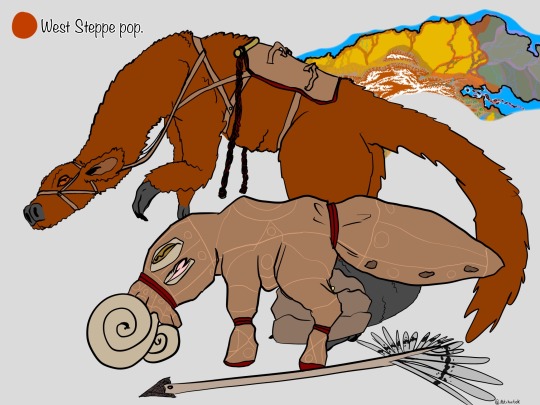
As you remember, Unzu are uniquely adapted to live in mountains, especially with domesticated mñats. Concurrently with colonization of Dumkatsdoñ, Lun Mñats arrived and settled on the Nыmamoz Sanan, known to indigenous people as Vunonán. Several generations of skirmishes followed, and while Rrék sutviprra have better understanding of the land and nature, Lan Mñats have the ability to swiftly retreat and regroup on the highlands - areas inaccessible for Rrék. Such advantage, unfortunately, led to the extermination of Vunonán Rrék on the mainland. While Lan Mñats are unparalleled on land, they lack any seafaring knowledge, allowing Rrék to flee on the islands. There, they would have to compete or ally with local sárrárr. Going from enclosed mountains to populated shorelines and seas has a perk of capability of cultural exchange. Further along the Kùón, there are more islands with more cultures. Kosán island is one of the bigger landmasses in the inner seas, being guarded by the Dotòm who understand the significance of their territory. Sutviprra of Kosán have loose connection with Jokosárrádi archipelago, which link up with Fúsòm, Fútemesen, Fújosén, Jozètín and Fújosárr. Fújosén poses as a rival to Kosán, being an island with the same potential.

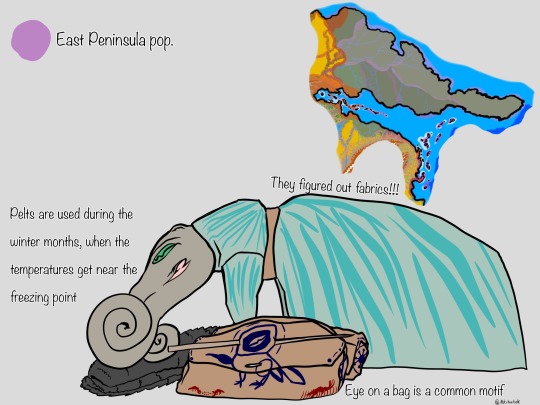
Lan Mñats up north introduced an unstable population of grazers to Joénky’n, causing an ecological disaster far beyond the scale of a simple göts. Without usual root systems, the soil is washed into the rivers by the rains. Rivers carry the mud down into the sea of Kùlónsárrèm, causing frequent algi blooms. Environment becomes uninhabitable for sealife, depriving islander sárrárr of much food they relied on. Sutviprra have to pay special attention to their environments to survive. The main architect of the Fusnmatàmian ecology is a séón tree. During harsh temperatures of a pre-blooming season, it generates oil around itself, making the area a genuine fire hazard. Bushfires both get rid of séón’s competition and prepare the soil for the next generation. The tree itself has several parasites and symbionts, who benefit from the clearing of territory. Many other plants don’t actively cause fires, but have adaptations to survive the fire. Séón trees have made their water storage double as a cooling , allowing them to survive the Torrùteúán and Sólúmèm have intricate root systems, allowing them to regenerate their leaves and stems after the fire season has passed. After the blooming, plants encounter a different issue - seedfeeding tetrapters and intetrognatas might destroy their prospects. Fèàsèmesón have their seeds inclosed in tough skin, while sàtùmosárr tangles onto itself to make it’s seeds inaccacible. In both cases, plants rely on herbivours to eat the fruits and swallow the seeds whole - that way they will be desperced wherever this creature goes in the past two weeks. Sárrárr also turn to this mode of feeding, along with sparse hunts and fungoid foraging. Animals on the island are familiar, but smaller than mainland speciments, provoking fears of hunger. To survive, Sudm have to manage their foodsources, rather than forage.


#sutviprra#art#speculative biology#worldbuilding#spec bio#alien design#exobiology#spec evo#speculative evolution#digital art
10 notes
·
View notes
Text
Bitcoin Volatility Fuels Market Anxiety; XBIT Decentralized Exchange Charts Steady Recovery
1. Regulatory Storm Amid Bitcoin’s ATH As Bitcoin’s price surpassed its all-time high (ATH) of $100,000 in early 2025, a global regulatory storm engulfed cryptocurrency markets. Centralized exchanges (CEXs) worldwide faced abrupt blockages, operational restrictions, or asset freezes, triggering widespread investor panic. Amid the turmoil, XBIT Exchange—a decentralized trading platform (DEX)—rapidly gained traction, with its trading volume surging 400% month-over-month and positioning itself as a secure harbor for Bitcoin holders.

2. Centralized Platforms Under Scrutiny In March 2025, the U.S. Securities and Exchange Commission (SEC) launched investigations into five major crypto platforms for compliance violations, while Japan’s Financial Services Agency (FSA) announced a sweeping review of all Bitcoin-related exchanges. Concurrently, mid-tier platforms like CoinTide and UltraX halted services indefinitely, freezing over $120 million in user assets. These events forced investors to confront a critical question: Can centralized platforms ever be truly secure?
3. Decentralized Solutions Regain Momentum The concept of decentralized exchanges (DEXs), once dismissed as niche tools due to technical complexity, has resurged under regulatory pressure. XBIT Exchange exemplifies this shift. Operating via on-chain smart contracts, the platform eliminates third-party custody, manual intervention, and Know Your Customer (KYC) requirements, adhering strictly to the principles of self-custody, transparency, and censorship resistance. Users interact directly through non-custodial wallets, with every transaction recorded immutably on the blockchain.

4. Demystifying Decentralized Exchanges A decentralized exchange operates entirely on blockchain networks, executing trades through automated smart contracts without holding user funds. Key features include:
Non-custodial design: Assets remain in users’ wallets until trade execution.
Tamper-proof execution: Transactions are verified by code, not human intermediaries.
Transparent audit trails: All activities are publicly verifiable on-chain.
XBIT currently supports Bitcoin, Ethereum, and major stablecoins, with cross-chain interoperability slated for Q3 2025.
5. Data-Driven Adoption Surge According to blockchain analytics firm DataLink, DEX usage surged 275% globally between March and May 2025, with 43% of new users migrating from CEXs after experiencing freezes or high fees. “After my funds were frozen on a traditional platform, I realized decentralization isn’t optional—it’s essential,” said Berlin-based investor Marlin Koch.
XBIT’s metrics underscore this trend: daily new wallet addresses exceed 5,200, while monthly transactions grew 320% year-over-year (YoY), rivaling legacy platforms.
6. XBIT’s Strategic Edge
Global node network: A distributed architecture minimizes risks of server seizures or exit scams.
On-chain risk scoring: Real-time security audits for every transaction.
User-centric interface: Features like one-click trading and QR-synced wallet logins lower barriers for retail investors.

7. Conclusion: Redefining Crypto’s Future As Bitcoin evolves from a speculative asset to a global hedge, the demand for secure, transparent trading infrastructure grows imperative. Decentralized platforms like XBIT are no longer ideological experiments but market necessities—offering resilience against regulatory volatility and redefining trust in digital finance.
2 notes
·
View notes
Text
How to Choose the Right Tech Stack for Your Web App in 2025

In this article, you’ll learn how to confidently choose the right tech stack for your web app, avoid common mistakes, and stay future-proof. Whether you're building an MVP or scaling a SaaS platform, we’ll walk through every critical decision.
What Is a Tech Stack? (And Why It Matters More Than Ever)
Let’s not overcomplicate it. A tech stack is the combination of technologies you use to build and run a web app. It includes:
Front-end: What users see (e.g., React, Vue, Angular)
Back-end: What makes things work behind the scenes (e.g., Node.js, Django, Laravel)
Databases: Where your data lives (e.g., PostgreSQL, MongoDB, MySQL)
DevOps & Hosting: How your app is deployed and scaled (e.g., Docker, AWS, Vercel)
Why it matters: The wrong stack leads to poor performance, higher development costs, and scaling issues. The right stack supports speed, security, scalability, and a better developer experience.
Step 1: Define Your Web App’s Core Purpose
Before choosing tools, define the problem your app solves.
Is it data-heavy like an analytics dashboard?
Real-time focused, like a messaging or collaboration app?
Mobile-first, for customers on the go?
AI-driven, using machine learning in workflows?
Example: If you're building a streaming app, you need a tech stack optimized for media delivery, latency, and concurrent user handling.
Need help defining your app’s vision? Bluell AB’s Web Development service can guide you from idea to architecture.
Step 2: Consider Scalability from Day One
Most startups make the mistake of only thinking about MVP speed. But scaling problems can cost you down the line.
Here’s what to keep in mind:
Stateless architecture supports horizontal scaling
Choose microservices or modular monoliths based on team size and scope
Go for asynchronous processing (e.g., Node.js, Python Celery)
Use CDNs and caching for frontend optimization
A poorly optimized stack can increase infrastructure costs by 30–50% during scale. So, choose a stack that lets you scale without rewriting everything.
Step 3: Think Developer Availability & Community
Great tech means nothing if you can’t find people who can use it well.
Ask yourself:
Are there enough developers skilled in this tech?
Is the community strong and active?
Are there plenty of open-source tools and integrations?
Example: Choosing Go or Elixir might give you performance gains, but hiring developers can be tough compared to React or Node.js ecosystems.
Step 4: Match the Stack with the Right Architecture Pattern
Do you need:
A Monolithic app? Best for MVPs and small teams.
A Microservices architecture? Ideal for large-scale SaaS platforms.
A Serverless model? Great for event-driven apps or unpredictable traffic.
Pro Tip: Don’t over-engineer. Start with a modular monolith, then migrate as you grow.
Step 5: Prioritize Speed and Performance
In 2025, user patience is non-existent. Google says 53% of mobile users leave a page that takes more than 3 seconds to load.
To ensure speed:
Use Next.js or Nuxt.js for server-side rendering
Optimize images and use lazy loading
Use Redis or Memcached for caching
Integrate CDNs like Cloudflare
Benchmark early and often. Use tools like Lighthouse, WebPageTest, and New Relic to monitor.
Step 6: Plan for Integration and APIs
Your app doesn’t live in a vacuum. Think about:
Payment gateways (Stripe, PayPal)
CRM/ERP tools (Salesforce, HubSpot)
3rd-party APIs (OpenAI, Google Maps)
Make sure your stack supports REST or GraphQL seamlessly and has robust middleware for secure integration.

Step 7: Security and Compliance First
Security can’t be an afterthought.
Use stacks that support JWT, OAuth2, and secure sessions
Make sure your database handles encryption-at-rest
Use HTTPS, rate limiting, and sanitize inputs
Data breaches cost startups an average of $3.86 million. Prevention is cheaper than reaction.
Step 8: Don’t Ignore Cost and Licensing
Open source doesn’t always mean free. Some tools have enterprise licenses, usage limits, or require premium add-ons.
Cost checklist:
Licensing (e.g., Firebase becomes costly at scale)
DevOps costs (e.g., AWS vs. DigitalOcean)
Developer productivity (fewer bugs = lower costs)
Budgeting for technology should include time to hire, cost to scale, and infrastructure support.
Step 9: Understand the Role of DevOps and CI/CD
Continuous integration and continuous deployment (CI/CD) aren’t optional anymore.
Choose a tech stack that:
Works well with GitHub Actions, GitLab CI, or Jenkins
Supports containerization with Docker and Kubernetes
Enables fast rollback and testing
This reduces downtime and lets your team iterate faster.
Step 10: Evaluate Real-World Use Cases
Here’s how popular stacks perform:

Look at what companies are using, then adapt, don’t copy blindly.
How Bluell Can Help You Make the Right Tech Choice
Choosing a tech stack isn’t just technical, it’s strategic. Bluell specializes in full-stack development and helps startups and growing companies build modern, scalable web apps. Whether you’re validating an MVP or building a SaaS product from scratch, we can help you pick the right tools from day one.
Conclusion
Think of your tech stack like choosing a foundation for a building. You don’t want to rebuild it when you’re five stories up.
Here’s a quick recap to guide your decision:
Know your app’s purpose
Plan for future growth
Prioritize developer availability and ecosystem
Don’t ignore performance, security, or cost
Lean into CI/CD and DevOps early
Make data-backed decisions, not just trendy ones
Make your tech stack work for your users, your team, and your business, not the other way around.
1 note
·
View note
Text

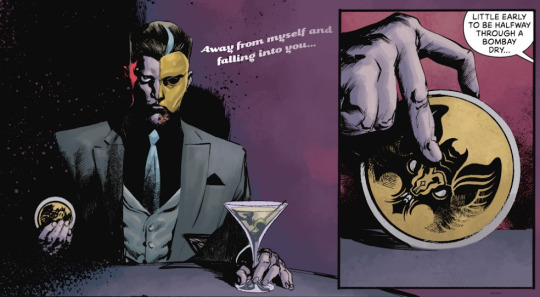
So the second issue opens with Bruce meeting Harvey Dent (who I guess has been doing better? Not sure since when....) in something between a classy jazz lounge and a seedy speakeasy. They have elaborate bat insignia coasters apparently... There is a lounge singer performing, keeping us with the musicality theme. Also Harvey's sporting this golden Phantom of the Opera look now like an absolute drama queen.

A curious detail here: The bar Harvey is wasting away in, is named after a Hindu deity, Bhairava[भैरव] is a wrathful emination of the god of destruction, Shiva.
Anyway the conversation is ridiculous and Harvey seriously delivers the line, "Look upon my golden face, Bruce Wayne." Anyway they establish that the normal mobsters have gone into hiding and that there is some kind of a change coming, but neither knows just what. Change, btw, is a theme here... sort of... it's supposed to be anyway.
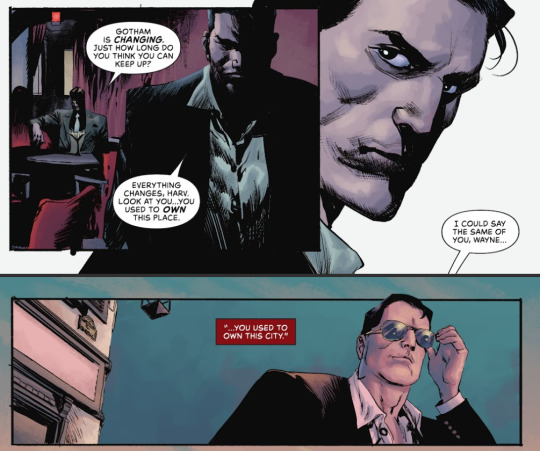
meanwhile the Orghams have already arrived in Gotham, which feels a little too quick honestly... We get this super weird and kind of frustratingly bland exposition dump where apparently the first Orgham to settle Gotham did so during the establishment of the fucking midatlantic colonies in 1692(the year of the start of the salem witch trials, btw...) which just raises all kinds of questions I know they weren't trying to... like why eastern european aristocracy was buying land on the North American continent with a bunch of anglosaxon heretic peasants. But in any case 1853 the name Arkham is apparently taken to protect business operations??? (Note that the American Civil War hasnt even happened at that point)


I gotta stop here to point out that this is just a wild series of tiny decisions to have made and laid out so explicitly here... So the eastern european family did not in fact immigrate to the U.S. during any of the notable and appropriate historical migration periods for that region??? The change of the name Orgham to Arkham was not a matter of integration into American culture, as many name changes of imigrants over history have been? (certainly not centuries after establishing themselves as American settlers and land owners) What a wasted opportunity to inject a little real world flavor into things.


Anyway, we learn the trust fund baby has magic hulk out powers too. The music box is revealed to have the power to actually reverse, as well as apparently trigger the effect. Batman is then concurrently figuring out via consultation with an imprisoned Maestro, that the music box isn't just randomly magic, but specifically musical pseudo science.
With the Maronis apparently broken off with, the Orgham agents in Gotham approach Harvey instead, and hit him with their "Azmer" dust, and now Two-Face is talking to him in his head again.

Now... for all my beef with the Orgham backstory (and oh boy is there more of that to come... dont you worry...) I really love this idea that the Azmer and the music tap into this kind of subconcious latency and that people like Bruce and Harvey are already so predisposed to carrying on their alter egos that their manifestations are more clear and distinct, where as some rando just goes frothing at the mouth mad and hulks out instead. And there's an aspect that I'll skip ahead to bring up: the Orgham goons all have a mask that allows them to transform. This whole talk of bringing out inner demons is cool and all, but the villains all just turn into fairly generically bigstrong monster men.

Okay so here's maybe my biggest issue with all this... (and i say this fully understanding that it is an unreasonably obtuse thing to have expected from pretty loosely associated hooks, but hear me out...) if we're juggling changing the city, the absence of arkham, the power of masks, some kind of ancient lovecraftian madness, barbatos and batman, and batman's declining health and Dawn of DC's (admitedly weak ass) passing the torch themes... then rather than some deep down personal demons being brought out by spooky song, what I would have really liked is for this all to have been about the Orghams having developed a method of channeling a vast unknowable wealth of abstract concepts and powers into the physical world via totems. The physical object reflects the idea and anchors vast formless powers into concrete images, funneling that impossible expanse into manageable human proportions. In that way the ancient evil remains unknowable without making its methods overly concrete and explained, the Orgham's relation to it becomes uniquely threatening without making them either underpowered or limited in their gimmick, and yet the parallel with Batman and the Gotham rogues becomes abundantly clear:

Batman has unwittingly and tactlessly reinvented this ancient ritual from scratch, and he has for years thus been channeling unchecked madness directly into his skull via his bat persona. So now the family has come to clamp down on this infringement of their ancient rites, and the source of it all is that some ancient ancestor of theirs ran off with their family secrets and spread them unchecked amongst Gotham's unknowing populace for generations, giving rise to Gotham's rouges gallery and all their costumed gimmicks, each faintly tapping into higher powers via their masks and aliases. And above all, Gotham itself is a living breathing psychic organism, and the power of masks works on it as well, and for decades now, Arkham Asylum was Gotham's mask: it projected the image of gothic horror and an archaic madhouse, and so that's the anchor the abstract powers of the aether had to channel themselves into the city through. With the Asylum gone, there is no anchor, and there is no mask, and city can do one of three things: put the mask back on, forge a new mask and a new persona, or face down a sort of withering psychic hangover as all of Gotham's psychic collective rides out the lingering madness raw and unfiltered.
So do we rebuild Arkham as it was, to uphold status quo, but in a way that ultimately means perpetuating the pipeline of madness from the aether into the city and its populace? Do we try to build something new, funneling different and "better" forces into the city, but via an equally tenuous and dangerous anchor? Or do we try to break the cycle entirely at the risk that the potential psychic overload of everything Gotham took into itself for a century taken without the filter of a mask could straight up kill it and everyone in it? And do the mask of Batman and the mask of Arkham go hand in hand? If we agree to retire Arkham, do we accept retiring The Batman as we know him as well? Can the city ever really move on?
That's the fucking story I wanted out of this. Along with maybe some cool immigrant anecdotes, and throwbacks to Dracula's whole London property investment world conquest scheme.
2 notes
·
View notes
Text
A Deep Dive into High-Risk Merchant Account Management
Article by Jonathan Bomser | CEO | Accept-Credit-Cards-Now.com

In today's era of digital commerce, the landscape of business has transcended traditional brick-and-mortar stores. E-commerce has emerged as a cornerstone of the global economy. However, with its rapid growth, it has brought along unique challenges, and one of these challenges revolves around effectively managing high-risk merchant accounts. In this article, we'll embark on a journey to delve into the complexities of high-risk merchant account management, shedding light on its pivotal role in empowering businesses to securely and efficiently accept credit cards.
DOWNLOAD THE A DEEP DIVE INFOGRAPHIC HERE
The Vitality of High-Risk Merchant Accounts in Payment Processing Tailored for industries grappling with distinct challenges, such as payment processing in high-risk sectors like online gaming and adult entertainment, these specialized accounts serve as a lifeline. They provide businesses with the capability to securely accept credit cards, fueling their growth and expanding their reach, especially in scenarios where traditional merchant accounts might be out of reach. High-Risk Merchant Account providers stand as crucial gateways to success in the fiercely competitive landscape of online commerce.
Merchant Processing: A Cornerstone Component Merchant processing is the bedrock of any business that relies on card payments. It operates as the engine that powers smooth and secure transactions. High-risk merchant processing, equipped with advanced fraud detection mechanisms and risk mitigation strategies, assures that businesses can operate without the fear of financial losses stemming from fraudulent activities.
The Role of E-commerce As businesses are increasingly migrating online, e-commerce payment processing has gained paramount importance. For e-commerce merchant accounts in high-risk industries, ensuring secure and seamless payment gateways is of utmost significance. These specialized accounts empower businesses to accept credit cards for e-commerce while effectively managing the inherent risks.
Credit Repair: A Distinct High-Risk Sector The credit repair industry treads the fine line between high risk and high reward. While it offers individuals the opportunity to restore their credit scores, it also tends to attract potential fraudsters. High-risk credit repair merchant processing is tailored to meet the specific needs of this industry, providing the means to accept credit cards for credit repair services while concurrently safeguarding against fraudulent activities.
CBD and the Imperative for High-Risk Merchant Accounts The thriving CBD industry presents unique challenges in the payment processing landscape. Classified as a high-risk industry due to regulatory ambiguities, CBD businesses necessitate specialized solutions. High-risk payment processing for CBD ensures that merchants can securely accept credit cards for CBD products without encountering legal complications.
youtube
The Future of High-Risk Merchant Account Management As technology advances and consumer preferences evolve, the high-risk merchant account management landscape stands on the cusp of further transformation. Payment gateway solutions are becoming increasingly sophisticated, offering real-time fraud detection, robust reporting, and seamless integration with e-commerce platforms. High-risk merchant account providers are in a continuous state of adaptation to meet the ever-evolving needs of businesses.
In the ever-expanding realm of e-commerce and high-risk industries, the capability to accept credit cards represents a lifeline for businesses. High-risk merchant account management is more than just a service; it signifies a strategic partnership that empowers businesses to grow while simultaneously mitigating risks. Ranging from credit card processing to payment gateways, these services play an indispensable role in ensuring secure and efficient transactions.
#high risk merchant account#high risk payment gateway#high risk payment processing#merchant processing#payment processing#credit card payment#credit card processing#accept credit cards#Youtube
18 notes
·
View notes